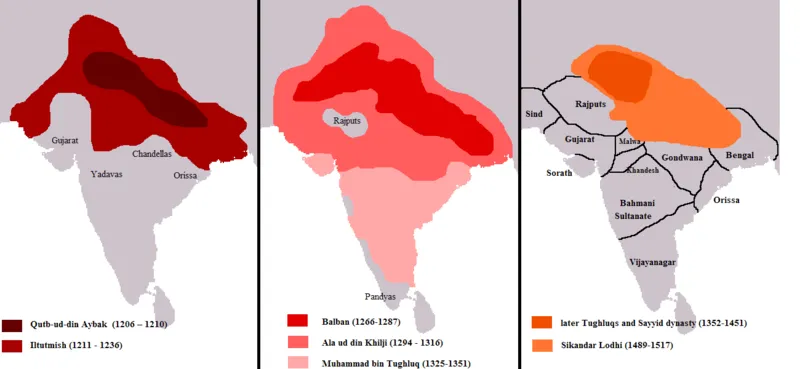Thuggees, a Sanskrit word meaning concealment, were an organized gang of professional assassins – sometimes described as the world’s first mafia – who operated from the 13th to the 19th centuries in India. Some old Turkic tales and modern unreliable academics and historians try to link thugs to a religious cult and deity called “Kali or Kalee” the goddess of death and destruction. This seems to be racist and part of campaign to defame Indian belief systems in favor of the Turkic invaders who were forcing their own version of Islam on indigenous Indians.
Certainly, thugs were not following any religious belief. Death in Hinduism is not treated as the end, but considered a fresh beginning. According to mythology, Kali is the fearsome form of Shakti, the slayer of evil, the destructor of adharma (unrighteousness). She has saved mankind from many daemons like Chand-Mund, Raktbeej, Shumb-Nishumb, etc. Given she is a form of Shakti, she is responsible for eliminating the negative forces inside us. Worshipping her is a way to thank her and seek her blessing in all the endeavors of life.
Accounts of a secret practice of murderers roaming India go back at least as far as the 13th century. The word ‘thug’ dates to early 13th-century India, when Thugs, or gangs of criminals, roamed from town to town, looting and pillaging. At its root, the word “Thuggee” derives from the Hindi (ṭhag), which means “deceiver”. Related words are the verb thugna (“to deceive”), from the Sanskrit (sthaga “cunning, sly, fraudulent”) and (sthagati, “he conceals”). This term, describing the murder and robbery of travelers, is popular in South Asia and particularly India. They mean the acts of Thugs, an organized gang of professional robbers and murderers. Thugs travelled in groups across the Indian sub-continent for six hundred years.
They were first mentioned in Ẓiyā-ud-Dīn Baranī’s History of Fīrūz Shāh, dated around 1356. The earliest known reference to the Thugs as a band or fraternity, rather than ordinary thieves, is found in Ziau-d din Barni’s History of Firoz Shah (written about 1356):
[In the reign of that sultan [about 1290], some Thugs were taken in Delhi, and a man belonging to that fraternity was the means of about a thousand being captured. But not one of these did the sultan have killed. He gave orders for them to be put into boats and to be conveyed into the lower country, to the neighbourhood of Lakhnauti, where they were to be set free. The Thugs would thus have to dwell about Lakhnauti and would not trouble the neighborhood of Delhi any more.] — Sir HM Elliot, History of India, iii. 141
The practice of Thuggees appeared with the Delhi Sultanate (1206–1526 AD). The Delhi Sultanate was a Turkic kingdom claiming Islam based mostly in Delhi that stretched over large parts of the Indian subcontinent for 320 years. Five dynasties ruled over Delhi Sultanate sequentially: the Mamluk dynasty (1206–90), the Khilji dynasty (1290–1320), the Tughlaq dynasty (1320–1414), the Sayyid dynasty (1414–51), and the Lodi dynasty (1451–1526). The first four dynasties (Mamluk, Khilji, Tughlaq and Sayyid) were of Turkic origin, and the last dynasty (Lodi) was of Afghan origin, who are Turkified Aryans.
Bands of Thugs traveled across the country posing as pilgrims, merchants, soldiers, or even royalty, in groups numbering anywhere from a few men to several hundred. Offering protection or company, they would befriend fellow travelers and slowly build their confidence along the road. Often the impostors would journey for days and hundreds of miles with their intended victims, patiently waiting for an opportunity to strike. When the time was right, typically while their targets were encamped and at their most relaxed, a signal would be given—reportedly “Bring the tobacco”—and the Thugs would spring.

Invasions, migrations, and slavery were normally associated with organized criminal gangs of thugs. From Scythia, India, and Iran the Huns, the Turkic, and the Mongols brought the practices of organized crime, Mafia, and terrorism to Europe, Arabia, Africa, and to the Americas.
To know who is fighting who in Syria, Iraq, Yemen, Libya, and whole Middle East and why; also to know who is really running the EU and the deep state in any country people need to look into the history of six Turkic groups.
The six Turkic groups are:
1- Turkic Muslim in Anatolia and Balkan, (fake Caucasians since Byzantine–Seljuq wars in 1048 Ad),
2- Turkic Shia Persians (fake Iranians since the Achaemenids in 550 BC),
3- Turkic Khazar Zionist Jews (fake Israelite since Eastern Tourkia in 650 AD),
4- Turkic rulers of Arabia (fake Arabs, following the death of Islam in 655 AD),
5- Turkic “Hindu” Indians and Gypsy (fake Aryans since the Persian conquest in 530 BC), and
6- Turkic Europeans (fake liberal Christians since the “Holy” “Roman” “Empire” in 962 AD)
These groups discovered Zoroastrianism before Moses’ time. They killed it, and used their Tengri cult mixed with few concepts from Zoroasterianism to invent Persian Zoroastrianism. They repeated that with the teachings of Moses, Yeshua,and Mohamed.
Trust me the teachings of Moses, Yeshua, and Mohamed, and Zoroaster all died soon after birth. Most monarchies, bankers, and politicians in Europe and USA are of Turkic making since the so-called English, French, American, and Russian “Revolutions”. These Turkic groups committed all sorts of crimes in Asia, Europe, Levant, Arabia, and Africa.
With just a little of common sense and investigation people can easily find the real historic Turkic connections between them beneath their deceptive mutual hostilities and malignant policies.
Those are the enemies of Hitler, Nazis, and Russia. And before them were the enemies of Alexander the Great.